Antique Imperial Russian Porcelain Plate From Tsar Kremlim Palace's Service
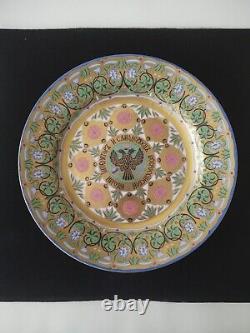
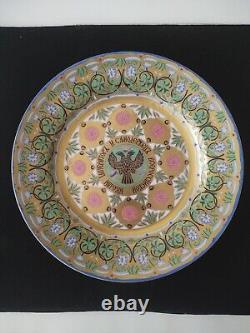
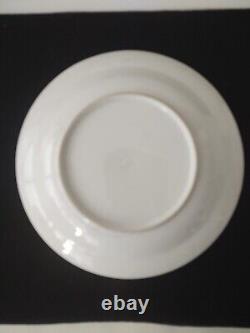
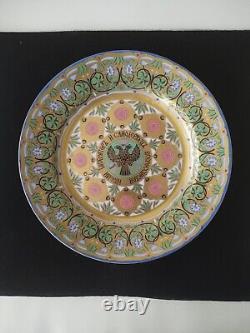
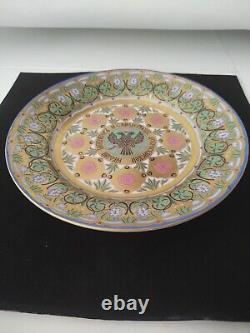
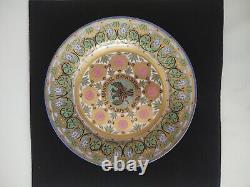

ANTIQUE IMPERIAL RUSSIA PORCELAIN PLATE FROM THE TSAR KREMLIM PALACE'S SERVICE. A Russian porcelain plate from the Kremlin Palace Service. This plate was made by the Imperial Porcelain Factory during the reign of Nicholas II on 1912/13 for the TERCENTENARY ROMANOV'S DINASTY to add more sets for all the guest that attended to KREMLIM'S GRAND PALACE' S DINNER CELEBRATION. Please see text under these lines after the Kremli's service's history. The center of the cavetto is painted with a black double-headed Imperial Eagle with crown, orb and scepter.
Surrounded by a gilt band inscribed'Nicholas the Emperor and Ruler of all the Russias'. Elaborate border decorated with blue and green flowers against a burnished gilt ground. Good conditions, no cracks, no hairlines, no chips, no damages at all. The Kremlim's service was Commissioned by Nicholas I for the Grand Kremlin Palace in Moscow, the Kremlin Service used ancient Russian patterns.
Looking for non-Western sources of artistic inspiration, Nicholas entrusted the young scholar, Fedor Solntsev, to study and record the vast riches of Russia's medieval past stored in the Kremlin Armory and other ancient sites. Several additions were made until 1913 to replace the broken pieces and add more settings for more guests. Solntsev's six-volume work became a manual of Russian medieval styles that had a lasting impact on Russian art of the nineteenth and twentieth centuries. The Kremlin Service was intended for coronations and other grand events.
It was last used in 1913 at the Tercentenary dinner in the Kremlin to celebrate three hundred years of the House of Romanov. THIS PLATE WAS MADE FOR. Fedor Solntsev designed the Kremlin Service based on the cloisonné enamel and gold plates and dishes from the collections of the Kremlin Armory, made for Tsar Alexis (reigned 1645-76), father of Peter the Great.
The Kremlin dessert plate is inscribed around the double-headed eagle in Cyrillic characters, Nicholas Emperor and Autocrat of All the Russias. The Kremlin Service consists of two parts, the White Service, used for soup, and the Gold Service, intended for dessert. It was made for five hundred people, with two thousand dinner plates, one thousand soup plates and one thousand dessert plates.
Dessert services were always elaborate, while dinner sets could be modest, their main embellishment being the state coat-of-arms, the double-headed eagle. During the tercentenary celebrations in.
Is being carried by a. Was a country-wide celebration, marked in the.From February 1913, in celebration of the ruling. After a grand display of wealth and power in. And a week of receptions at the. The Imperial family embarked on a tour following. S route after he was elected Tsar in 1613, a sort of pilgrimage to the towns of ancient.
Associated with the Romanov dynasty, in May. It has been described as an'extravaganza of pageantry' and a tremendous propaganda. Exercise; but among its principal goals were to'inspire reverence and popular support for the principle of autocracy', and also a reinvention of the past,'to recount the epic of the "popular Tsar", so as to invest the monarchy with a historical legitimacy and an image of enduring permanence at this anxious time when its right to rule was being challenged by Russia's emerging democracy', a retreat'to the past, hoping it would save them from the future'. Throughout the jubilee, the leitmotiv as it were was the cult of seventeenth century Muscovy, with its patrimonialism (with the Tsar owning Russia as a private fiefdom), personal rule with the Tsar a representation of God.
And the concept of a mystical union between the'Little Father Tsar' and his Orthodox subjects, who revered and adored him. In the celebrations, the symbols of the Tsar were in the centre, with all symbols of the state pushed far into the background. This item is in the category "Collectibles\Cultures & Ethnicities\Russian". The seller is "afarjun17" and is located in this country: US. This item can be shipped worldwide.
